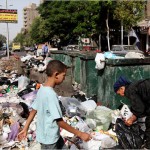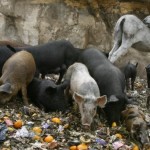No, this is not another post about MVRDV’s infamous porcine skyscraper containing “pregnancy parlors,” “delivery dens,” and “truffle gardens,” for pigs to enjoy before making their inevitable journey through the slaughterhouse at its base. News reports have trickled in over the last few months regarding Egypt’s decision to kill all the pigs in Egypt this past spring in what was first described as an attempt to combat swine flu.
For more than half a century, a community of Christians who live on the eastern edge of the Cairo have collected the trash, sold recyclables, and fed organic waste to their pigs – which they then slaughtered and ate. The pigs used to eat tons of organic waste, but now rotting food piles up in the streets, exposing the fragile nature of the community’s waste disposal practices: people do not take their garbage out – they are accustomed to seeing someone collect it from their door.
Animal architecture attempts to explore the interaction between humans and nature in the functioning of cities, and it should not be surprising that killing pigs that provided a valuable public service by recycling the public’s food scrap waste would lead to problems.
The recent trash problem was compounded when after the christians refused to continue pick up the organic waste, employees of one other multinational waste management companies hired to deal with the trash stopped working as well, in a dispute with the city.
This makes us think of the role animals play in the urban “civic ecology of the city,” and we’re looking forward to checking out two movies which recently covered the subject, “Garbage Dreams,” and Marina of the Zabaleen.” By globalizing the waste system in Cairo, modern waste management techniques are perhaps missing out on enthusiasm and ingenuity; and the pig farming, recycling, garbage collectors in Egypt surely have their counterparts in other megacities. Egypt has been promoting modern companies from Spain and Italy to take over the future of waste hauling in Cairo, but many residents cling to the old method, expecting the Zabaleen to come to their doors, refusing to pay the fees charged to take trash to newly created desert landfills.
Can we find ways to recycle more organic waste here in the United States? With composters rapidly becoming the new suburban lawn ornament, and composting centers cropping up in some cities, we can certainly do better on the backs of those of us who are disciplined enough, but it seems unlikely that we will integrate livestock back into the process of recycling our waste at a large scale anytime soon. Perhaps it is globalization and a great diversity of sourcing opportunities which has allowed us to abandon urban livestock: in 1943, London had 4,000 pig raising clubs in the city limits, with 105,000 kept inside the city. Certainly there is enough scraps to feed pig farming endeavors in most cities, but it will take special conditions to allow pigs to get a greater footing into urban settings in the United States. What if some new mixed use developments called for a “biodiversity requirement” as part of their mixed use? Encouraging backyard chicken coops, small rabbit operations, and pig keeping?












